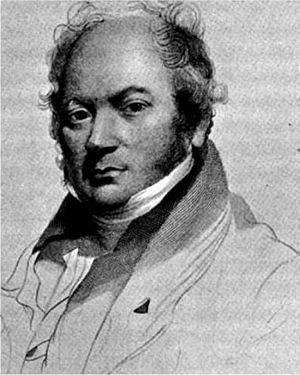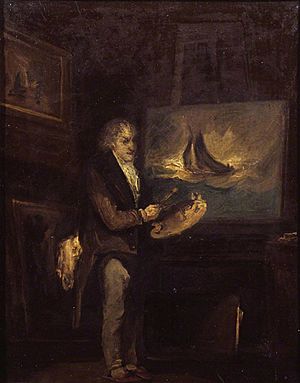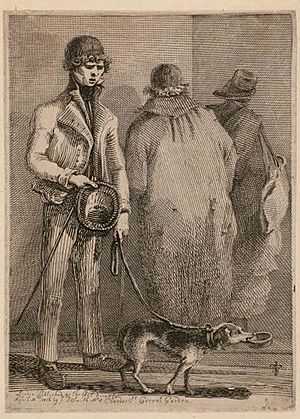John Thomas Smith (engraver) facts for kids
Quick facts for kids
John Thomas Smith
|
|
|---|---|

J.T.Smith by William Skelton
|
|
| Born | 1766 Hackney carriage in London
|
| Died | 1833 London
|
| Other names | "Antiquity" Smith |
| Education | included the Royal Academy |
| Occupation | Engraver, draughtsman, curator |
| Employer | British Museum |
| Spouse(s) | Anna Maria (Prickett) |
John Thomas Smith, also known as Antiquity Smith (1766–1833), was an English artist and writer. He was a talented engraver, draughtsman (someone who draws plans or sketches), and an antiquarian. An antiquarian is a person who studies old things. He also worked as a keeper of prints for the famous British Museum in London.
Contents
Life of John Thomas Smith
John Thomas Smith was born on June 23, 1766, in a very unusual place: the back of a Hackney carriage (a type of taxi) in London. His mother was on her way home at the time. He was named John after his grandfather and Thomas after his great-uncle, Admiral Thomas Smith. His father, Nathaniel Smith, was a sculptor who worked for Joseph Nollekens. Later, his father became a printseller.
Early Art Training
John Thomas Smith first tried to become a sculptor, just like his father, by training with Joseph Nollekens. However, he soon left to study art with John Keyse Sherwin and at the prestigious Royal Academy in London. After three years, he decided to earn a living using his drawing skills.
He gave up his plans for drawing landscapes and acting to focus on a big project called Antiquities of London and its Environs. This book became one of his favorite works. Because of this project, Smith became widely known as "Antiquity Smith."

In 1796, a young artist named John Constable met Smith. Smith became an informal art mentor to Constable, helping him with his artistic journey.
Major Works and Discoveries
Smith published several books of engravings and also taught drawing in Edmonton. In 1807, he published what is considered his most important work, Antiquities of Westminster. This book was inspired by old paintings found during construction work on the Houses of Parliament in 1800.
Smith and another artist, Charles Gower, were invited to see these paintings. Smith got permission to sketch them. He had to work very early in the morning to avoid the construction workers. It's said that the workers often destroyed what he had just finished sketching! He kept working like this for six weeks. After that, another artist took over, but Smith had already made a complete record. His published book contained over a hundred drawings of old buildings and items in Westminster that no longer exist today.
Between 1810 and 1815, Smith created drawings and engravings of well-known beggars in London. He published these in a book called The Streets of London: Anecdotes of Their More Celebrated Residents.
Working at the British Museum
In September 1816, Smith was offered an important job: Keeper of the Prints department at the British Museum. This job still allowed him to sketch and draw. His next book, Vagabondiana, or Anecdotes of Mendicant Wanderers through the Streets of London, had an introduction written by Francis Douce, who had also worked at the British Museum.
Smith, Douce, and Sir William Beechey were in charge of carrying out the will of Joseph Nollekens (the sculptor Smith's father worked for). Smith was reportedly disappointed with the small amount of money he received from Nollekens' will. This led him to write a very honest, and some say harsh, biography called Nollekens and His Times. While the description of Nollekens was not very kind, the book also included short biographies of other important people. These parts are very valuable for art historians today. Smith's biography of the famous artist William Blake was especially important. It was one of the first and was based on Smith's own experiences with Blake, as they stayed in touch after meeting.
Later Life and Legacy
John Thomas Smith passed away from a lung infection on March 8, 1833, at his home in London. He left behind his wife, Anna Maria, whom he had married 45 years earlier, and an adult son and daughter. He was buried privately on March 16.
After Smith's death, his friends and executors published three more of his works: Cries of London in 1839, Book for a Rainy Day, and Antiquarian Ramble in the Streets of London in 1846.
The Rule of Thirds
In 1797, Smith wrote a work called Remarks on Rural Scenery. This book contains what is believed to be the earliest mention of the "rule of thirds" in art. The rule of thirds is a simple guideline used in visual arts, like painting and photography. It suggests placing important parts of an image along lines or at their intersections, dividing the image into nine equal parts. This can make compositions more balanced and interesting.
Works by John Thomas Smith
- Remarks on Rural Scenery, 1797
- Antiquities of Westminster, 1807
- The Streets of London: Anecdotes of Their More Celebrated Residents, 1815
- Vagabondiana, or Anecdotes of Mendicant Wanderers through the Streets of London, 1817
- Nollekens and his Times. 2 volumes 1828
Published After His Death
- Cries of London (edited by John Bowyer Nichols, 1839)
- Antiquarian Ramble in the Streets of London (edited by Charles Mackay, 1846)
- A Book for a Rainy Day: or, Recollections of the Events of The Last Sixty-Six Years, 1905


